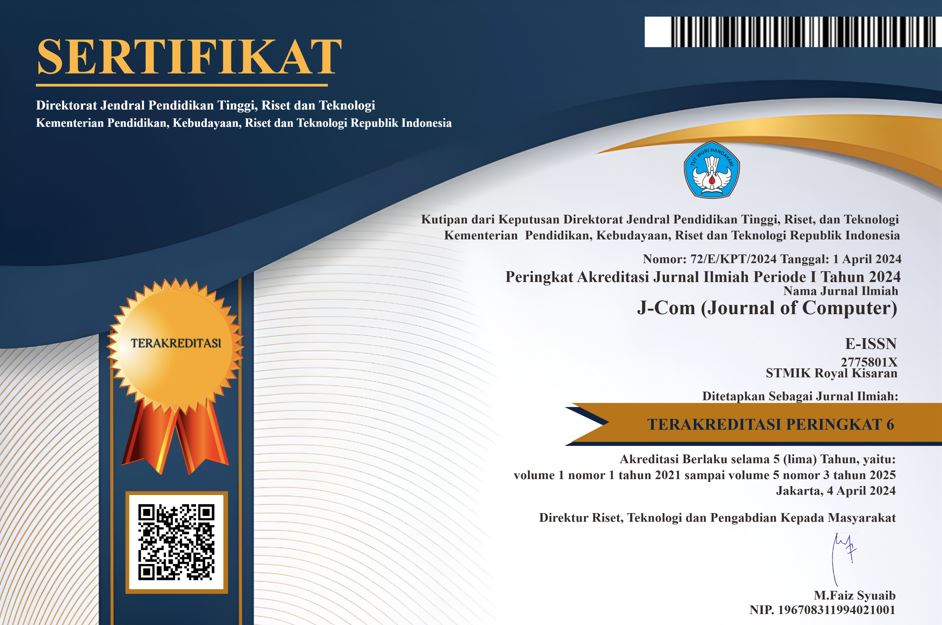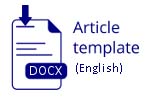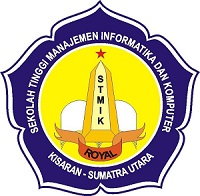DESIGN AUGMENTED REALITY FOR PROPERTY IN JIARMAH GROUP
Abstract
Abstract: Augmented reality is a technology that combines the virtual world and the real world in the form of two-dimensional or 3D objects in real time. This study uses the markerless augmented reality method to display the object. This study uses the prototype method where researchers listen to customers, build or revise mockups and customer test drive mockups. This augmented reality application was created using the Blender, Unity, Sketchup Pro and Vuforia SDK applications. Making three-dimensional objects is made using Blender and Sketchup Pro while making applications using Unity and Vuforia SDK. The results of the research on the application that was made were tested using blackbox testing where the test results obtained "as expected" which means the application is functioning and working properly.
Keywords: augmented reality; markerless augmented reality; 3D
Abstrak: Augmented reality adalah teknologi yang mengubah realitas menjadi objek dua dimensi atau tiga dimensi secara real time. Studi ini menggunakan metode augmented reality tanpa penanda untuk mengungkap objek. Penelitian ini menggunakan metode prototipe, di mana peneliti mendengarkan pelanggan, mengembangkan atau mengubah maket, kemudian meminta pelanggan untuk menguji coba maket tersebut. Aplikasi augmented reality ini dibuat menggunakan Blender, Unity, Sketchup Pro, dan Vuforia SDK. Objek tiga dimensi dibuat menggunakan Blender dan Sketchup Pro, sedangkan aplikasinya dibuat menggunakan Unity dan Vuforia SDK. Hasil penelitian pada aplikasi yang diuji menggunakan pengujian blackbox yang mendapatkan hasil "sesuai harapan" yang memiliki arti aplikasi sudah berfungsi dan bekerja dengan baik.
Kata kunci: augmented reality; markerless augmented reality; 3D
References
A. D. Rachmanto and M. S. Noval, “Implementasi Augmented Reality Sebagai Media Pengenalan Promosi Universitas Nurtanio Bandung Menggunakan Unity 3D,†FIKI |Jurnal Teknol. Inf. dan Komun., vol. 9, no. 1, pp. 29–37, 2018, [Online]. Available: https://jurnal.unnur.ac.id/index.php/jurnalfiki/article/view/237
M. Saefudin and A. Julisawati, “Sistem Pemasaran Properti Menggunakan Teknologi Augmented Reality di Perumahan Pamulang Lestari Residence,†J. Ilm. Komputasi, vol. 18, no. 4, 2019, doi: 10.32409/jikstik.18.4.2676.
Y. F. Tielung et al., “Penerapan User Defined Target Pada Augmented Reality Sebagai Media Pengenalan Gereja GMIM Sentrum Manado,†J. Tek. Inform., vol. 14, no. 1, pp. 121–128, 2019, doi: 10.35793/jti.14.1.2019.23984.
A. Zakir, D. Irwan, and P. Harliana, “Penerapan Augmented Reality dalam Media Periklanan Katalog Interaktif untuk Bisnis Property,†Konf. Nas. Teknol. Inf. dan Komput., vol. I, pp. 69–77, 2017.
S. L. B. Ginting and F. Sofyan, “Aplikasi Pengenalan Alat Musik Tradisional Indonesia Menggunakan Metode Based Marker Augmented Reality Berbasis Android,†Maj. Ilm. UNIKOM, vol. 15, no. 2, pp. 139–154, 2017, doi: 10.34010/miu.v15i2.554.
Y. Pernando and A. A. M. Cundana, “Inla Goes To School Augmented Reality Analysis and Design,†JURTEKSI (Jurnal Teknol. dan Sist. Informasi), vol. 8, no. 1, pp. 95–102, 2021, doi: 10.33330/jurteksi.v8i1.1239.
A. Nugroho and B. A. Pramono, “Aplikasi Mobile Augmented Reality Berbasis Vuforia Dan Unity Pada Pengenalan Objek 3D Dengan Studi Kasus Gedung M Universitas Semarang,†J. Transform., vol. 14, no. 2, p. 86, 2017, doi: 10.26623/transformatika.v14i2.442.
T. Arifianto, “Perancangan Aplikasi Furniture Home Design 3d Dengan Menerapkan Teknologi Augmented Reality Berbasis Android,†vol. 2, no. 1, pp. 15–20, 2017.
] Muhammad Qadriyanto et al., “Rancang Bangun Aplikasi Visualisasi 3D Furniture Interior Rumah Menggunakan Augmented Reality Dengan Metode Markerless Berbasis Android,†J. Coding, Sist. Komput. Untan, vol. 06, no. 03, pp. 237–246, 2018.
M. Michael, A. Trisnadoli, and R. Suhatman, “Buku Cerita Rakyat Riau Ketobong Keramat Berbasis Markerless Augmented Reality (AR) dengan Teknik User Defined Target,†J. Appl. Informatics Comput., vol. 3, no. 2, pp. 90–95, 2019, doi: 10.30871/jaic.v3i2.1543.
A. A. M. C. Yonky Pernando, “INLA GOES TO SCHOOL AUGMENTED REALITY ANALYSIS AND DESIGN,†vol. VII, no. 1, pp. 95–102, 2021, doi: https://doi.org/10.33330/jurteksi.v8i1.1239.
N. M. Farhany, S. Andryana, and R. T. Komalasari, “Aplikasi Augmented Reality Sebagai Media Informasi Museum Fatahillah Dan Museum Wayang Menggunakan Metode Markerless,†J. ELTIKOM, vol. 3, no. 2, pp. 104–111, 2019, doi: 10.31961/eltikom.v3i2.140.
P. A. Mahardika, I. M. A. Suyadnya, and K. O. Saputra, “Rancang Bangun Aplikasi Simulasi Dekorasi Ruangan dengan Memanfaatkan Teknologi Markerless Augmented Reality,†J. Comput. Sci. Informatics Eng., vol. 3, no. 1, pp. 82–90, 2019, doi: 10.29303/jcosine.v3i1.238.
M. Santoso, C. R. Sari, and S. Jalal, “Promosi Kampus Berbasis Augmented Reality,†J. Edukasi Elektro, vol. 5, no. 2, pp. 105–110, 2021, doi: 10.21831/jee.v5i2.43496.
A. M. Aries Suharso, Jajam Haerul Jaman, “Brosur Digital Untuk Fitur Eksterior Produk Otomotif Berbasis,†J. Integr. Technol., vol. 6, no. 1, pp. 25–30, 2020, [Online]. Available: https://journal.nurulfikri.ac.id/index.php/JTT
D. W. T. Putra, P. Windyana, A. Syahrani, and P. Mandarani, “Pengaruh Jarak Deteksi Marker Terhadap Waktu Delay Pada Augmented Reality,†Edik Inform., vol. 6, no. 2, 2020.














